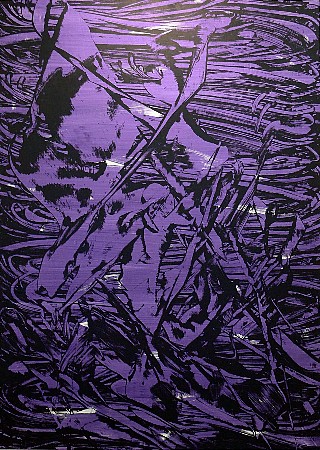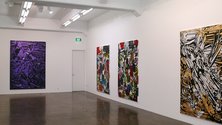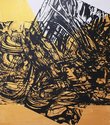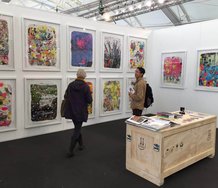Julian McKinnon – 2 April, 2013
For me a question does arise from Comic Drop. Is this kind of dealer exhibition something Millar does simply as a means to sustain her more expansive installation work or to appease a covetous market? Is it a tongue in cheek or ironic spin on an old game where artists and their dealers are beholden to commercialism? It'd probably be naive to think otherwise.
Picture a comic strip with two characters standing in front of a Judy Millar painting. You could make it one of those Lichtenstein single frame images. What might the snappy one liner say? How about: “My kid couldn’t do that.”
Comic Drop is Millar’s latest exhibition at Gow Langsford gallery on Lorne St. The main gallery show room is packed with large-scale paintings, which at first glance are recognisable to anyone familiar with Millar’s work. Gestural splatters of paint with discernible finger marks wander across the painted surface creating an elusive depth and form.
A few seconds of viewing later it kicks in that the works are overlaid with screen prints - Millar’s gestural marks enlarged and printed over the painted surface. These prints are identical in the case of four of the largest works - all of which are titled Zoomzoom. At first glance the reading isn’t too different from her more familiar works, but there’s something else at play. A new terrain of multiples and the comic book effect alluded to in the show title - it’s hard to dismiss the shift as purely stylistic.
The gallery’s exhibition blurb reckons: “In these works Millar continues to take on the history of expressive painting and turn it inside out.” Interesting to note that Millar also stated in a 2005 interview with Robert Leonard: “…every time I make a painting I’m dragging the whole history of painting with me.” So let’s dig about this history of painting for a bit. We might disinter a few recognisable artefacts - Pollock’s expressive splatters, Rothko’s sublime colour fields, Lichtenstein’s comic book print matrix, and Warhol’s multiples. Let’s throw in Twombly’s lyrical scribbling for good measure. Ooh, and Polke’s sorcery of print with paint. Needless to say there are myriad other influences at play, but the graphic sensibility of Comic Drop could well be distilled from this witch’s brew of painterly references.
Someone suggested that Millar’s works are classic Ab-Ex that arrived at the party some fifty years late. That doesn’t quite gel. Her paintings are definitely having a cosy cup of tea and a chat with Ab-Ex, and I suspect pop art is also at the table, though personally I don’t see it as any more anachronistic than Julie Mehretu’s tête-à-tête with geometric abstraction. Invariably painting references and engages with the past as it’s created anew - as Millar put it (also in the Leonard interview) “Painting constantly redefines itself, but in terms of its own history.”
Part of what fascinates me about these works is their dynamic oscillation between illusion and surface - the shock of colour against white, thin washes that bleed into the obscurity of gesso, the friction of the print against the paint - archetypal forms emerge and subside before your eyes. (It’s interesting to note that some of the works listed in the exhibition brief don’t feature the overlaid prints. The difference in graphic dialogue is subtle, but noticeable. Concealed in the back offices, they’re terrific).
I was standing in the gallery enthralled when someone asked me, quite earnestly, “What am I missing?” It started a conversation that I think caused the other party’s eyes to glaze over. Millar’s work can be a little esoteric in its concerns. Those without an education in painting - and that’s most people - can still find it challenging. If I were to walk into an engineering conference no doubt the discussion would be lost on me. I might even mistake it for nonsense. Perhaps fair to say that there’s painting for the public and there’s painting for painters.
Nevertheless the work is in a public context (There’s also a work of Millar’s on display in the excellent exhibition Partner Dance currently showing at Auckland Art Gallery) - as such it’s participating in the mainstream art world and public discourse. It would be unfortunate to claim that some art is really only for an elite audience - then again it’s probably true that only a relatively tiny percentage of the population of this country participate in the visual arts. Of those who do how many are going to engage with the painterly concerns of the work? The answer is, well, enough. Perhaps Millar will always have a few naysayers, though I doubt she loses any sleep over them. Why would she? She’s become one of New Zealand’s most accomplished painters in any period of our history.
For me a question does arise from Comic Drop. Is this kind of dealer exhibition something Millar does simply as a means to sustain her more expansive installation work (Giraffe-Bottle-Gun, The Rainbow Loop etc) or to appease a covetous market? Is it a tongue in cheek or ironic spin on an old game where artists and their dealers are beholden to commercialism? It’d probably be naive to think otherwise. There are some purists that think artists should live by a kind of idealistic bonhomie, finding all nourishment and fulfilment in the realisation of their work. On a rose-tinted, pipe-dreamy day I’ll happily go there myself. But in the cash obsessed and money-governed world of today does that really stack up?
Looking around the room it’s clear that the hungry ghosts of the art-collecting underworld are still ravenous for her output. I can see why. I’d gladly take Raft, that purple one on the back wall, hang it in my living room and let my eyes chase the paint splatters and emergent forms day after day, month after month, year after year.
Julian McKinnon
Recent Comments
John Hurrell
The nature of Millar's silkscreens intrigues me, what Julian here calls 'Lichtenstein’s comic book print matrix'. There is a dotty ...









 Advertising in this column
Advertising in this column Two Rooms presents a program of residencies and projects
Two Rooms presents a program of residencies and projects



This Discussion has 1 comment.
Comment
John Hurrell, 10:43 a.m. 3 April, 2013 #
The nature of Millar's silkscreens intrigues me, what Julian here calls 'Lichtenstein’s comic book print matrix'. There is a dotty grain, very different close up from the negative wipes of her usual smeary painting methodology. The background paint, when dark toned, drowns out (from behind) the screened over forms, so you need to look at several stretchers to mentally form an accurate composite image of the gestural screen 'calligraphy'.
Participate
Register to Participate.
Sign in
Sign in to an existing account.